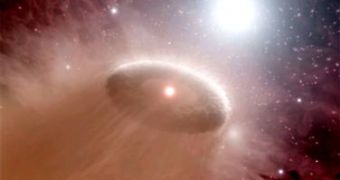It is the general belief of astronomers that planets are created in flat disks of gas and dust, called protoplanetary disks, which swirl around young, cool stars, and are slowly drawn together by a forming gravitation nucleus. According to standard planet-formation theory, over millions of years the particles clump together in space and grow in size like dust bunnies.
They knew that radiation from very massive stars can evaporate the planet-forming discs of gas and dust around other nearby stars. But the exact size of the "danger zone" around massive stars was not known.
Now, astronomers have determined how far away from its hot stellar neighbors a star must be if a swirling disk of dust around it is to stand a chance of forming planets.
Using NASA's Spitzer Space Telescope, Zoltan Balog of the University of Arizona in Tucson, US, and colleagues created the first maps of so-called planetary "danger-zones," areas where winds and radiation from super-hot stars can strip younger, cooler stars like our sun of their planet-forming materials.
They analyzed massive stars in the Rosette Nebula, a star-forming region 5200 light years from Earth.
The findings suggest that as long as cool stars lie beyond about 1.6 light years, or nearly 10 trillion miles, of any hot stars, they can form planets.
In the case of those at closer distances, the number retaining dusty discs dropped to 27%, suggesting that many have had their discs blown away by the massive stars. "Stars move around all the time, so if one wanders into the danger zone and stays for too long, it will probably never be able to form planets," Balog says. "The edges of the danger zone are sharply defined. It is relatively safe for protoplanetary disks outside it, whereas a disk that gets dragged along by its star to be really close to an O-star could disappear in as fast as a hundred thousand years."
However, stars passing through these danger zones might not be completely sterilized as far as planet formation is concerned.
If planets can form fast enough, they could coalesce before radiation has a chance to blow the raw material away. One theory says gas giant planets like Jupiter could form in less than a million years, which might be fast enough to avoid the evaporation problem.
Also, one previous study suggests that blowing away some of the gas in a dusty disc might actually aid the formation of planets, because gas can make it harder for the dust to clump together and form larger objects.
Still, this "danger zone" theory does not explain how planets can form around pulsars, spinning stellar corpses that also emit large amounts of radiation, so they must have formed by some rather different mechanisms.

 14 DAY TRIAL //
14 DAY TRIAL //